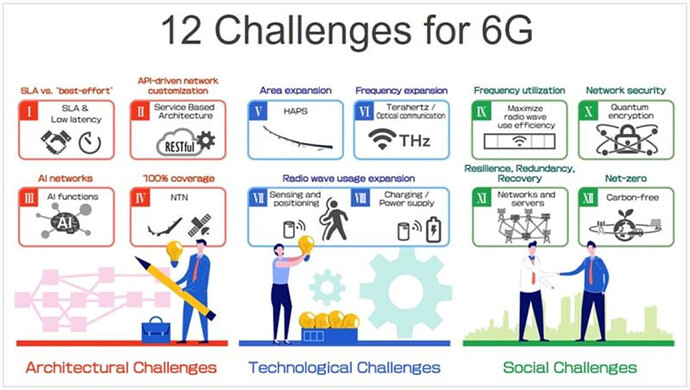Terahertz (THz) waves
![]() Terahertz (THz) waves: Type of electromagnetic radiation with frequencies ranging from 300 GHz to 3 THz. They are the highest frequency band in the microwave spectrum, and they are just below the visible light spectrum.
Terahertz (THz) waves: Type of electromagnetic radiation with frequencies ranging from 300 GHz to 3 THz. They are the highest frequency band in the microwave spectrum, and they are just below the visible light spectrum.
THz waves Advantages:
![]() Very high data rates: This could enable 6G networks to offer data rates of up to 1 terabit per second (Tbps).
Very high data rates: This could enable 6G networks to offer data rates of up to 1 terabit per second (Tbps).
![]() Low latency: This could enable new applications, such as self-driving cars and remote surgery.
Low latency: This could enable new applications, such as self-driving cars and remote surgery.
![]() Better penetration: THz waves can penetrate materials that are opaque to other forms of electromagnetic radiation, such as concrete and walls. This could make it possible to use 6G networks in indoor environments.
Better penetration: THz waves can penetrate materials that are opaque to other forms of electromagnetic radiation, such as concrete and walls. This could make it possible to use 6G networks in indoor environments.
THz waves challenges:
![]() Short range: They cannot be used to transmit data over long distances. This could limit the use of 6G networks to small, confined areas.
Short range: They cannot be used to transmit data over long distances. This could limit the use of 6G networks to small, confined areas.
![]() Absorption: THz waves are easily absorbed by water and other materials, which could make it difficult to use them in outdoor environments.
Absorption: THz waves are easily absorbed by water and other materials, which could make it difficult to use them in outdoor environments.
![]() Development: THz waves are still in the early stages of development, and there are a number of technical challenges that need to be addressed before they can be used for commercial wireless communications.
Development: THz waves are still in the early stages of development, and there are a number of technical challenges that need to be addressed before they can be used for commercial wireless communications.
Use cases for THz waves in 6G:
![]() Virtual reality (VR) and augmented reality (AR):
Virtual reality (VR) and augmented reality (AR):
![]() Self-driving cars:
Self-driving cars:
![]() Industrial automation: THz waves could be used to automate factories and other industrial facilities.
Industrial automation: THz waves could be used to automate factories and other industrial facilities.
 Quantum communications
Quantum communications
![]() Quantum communications is a new field of telecommunications that uses the principles of quantum mechanics to transmit data. Quantum communications offers a number of potential advantages over traditional wireless communications, including:
Quantum communications is a new field of telecommunications that uses the principles of quantum mechanics to transmit data. Quantum communications offers a number of potential advantages over traditional wireless communications, including:
![]() Unhackable: Its based on the laws of quantum mechanics, which make it impossible to eavesdrop on or intercept data. This could make it an ideal solution for applications that require high levels of security, such as military communications and financial transactions.
Unhackable: Its based on the laws of quantum mechanics, which make it impossible to eavesdrop on or intercept data. This could make it an ideal solution for applications that require high levels of security, such as military communications and financial transactions.
![]() High data rates: It can theoretically offer much higher data rates than traditional wireless communications. This could enable new applications, such as real-time videoconferencing and high-definition streaming.
High data rates: It can theoretically offer much higher data rates than traditional wireless communications. This could enable new applications, such as real-time videoconferencing and high-definition streaming.
![]() Low latency: Theoretically offer much lower latency than traditional wireless communications. This could enable new applications, such as self-driving cars and remote surgery.
Low latency: Theoretically offer much lower latency than traditional wireless communications. This could enable new applications, such as self-driving cars and remote surgery.
Some challenges include:
![]() Complexity: It requires specialized hardware and software. This could make it difficult to deploy and use quantum communications networks.
Complexity: It requires specialized hardware and software. This could make it difficult to deploy and use quantum communications networks.
![]() Cost:
Cost:
![]() Standardization: There is currently no international standard for quantum communications
Standardization: There is currently no international standard for quantum communications
Use cases for quantum communications in 6G:
![]() Secure military communications: It could be used to transmit secure military communications. This would make it much more difficult for enemies to eavesdrop on or intercept military communications.
Secure military communications: It could be used to transmit secure military communications. This would make it much more difficult for enemies to eavesdrop on or intercept military communications.
![]() Secure Financial transactions
Secure Financial transactions
![]() Remote surgery
Remote surgery
LinkedIn: ![]()
